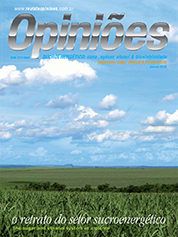Luiz Custódio Cotta Martins
President of Siamig and of Sindaçúcar - Minas Gerais
Op-AA-25
Preparing for a new cycle
The Brazilian sugar-based energy industry’s 2010/11 harvest season appears to be one of recovery. A relief harvest for companies hard hit by the 2008 financial crisis, in the course of the strong investment cycle that took place in previous years. Following a turbulent period, the market has rebounded to a sustainable start of a new growth period.
However, such decision will take place in another context, different from the one that drove the previous cycle, characterized by a more mature production structure, with a high degree of professionalization warranting better planning of decisions. The previous investment cycle caused some commotion and more importantly, left lessons for the future.
In order to understand them, let us go back a little to analyze the fundaments and the consequences that entrepreneurial decisions brought about in Brazil’s production structure in this period. This cycle allowed the industry to more than double sugarcane production in the past 10 years, based on three fundaments:
1. The oil price, with the quest for an alternative to expensive oil.
2. The domestic ethanol market, based on the launching, and consumers’ acceptance, of dual-fuel vehicles.
3. The concern about climate change and the quest for a renewable and clean fuel. Based on these three pillars, all mills in Brazil undertook some kind of expansion. One believed that the country would uphold its share of the world sugar market, that it would greatly increase ethanol sales to the domestic market and that a significant opening of foreign ethanol markets would occur.
This Brazilian industry was characterized by predominantly family management and very limited participation of foreign capital. The change of this structure caused major commotion in this industry. Several companies managed by families, many of which were responsible for the current status of our production, had to sell their business.
Investment funds that had entered Brazil with much appetite, multinational corporations that had entered the industry paying high amounts for assets they purchased, apart from other national groups that saw in this industry a means to diversify their investments, were also adversely affected. For the glorious survivors the outcome was the lessons learned, which need to be discussed by the companies:
1. The need for more professionalization.
2. Production diversification as a means to reduce risk.
3. The need to reduce costs, maximizing production and increasing efficiency.
4. Accepting the fact that one needs to prepare companies’ structure to bring in a strategic partner.
Based on these lessons, the industry is advancing towards a new investment cycle. Entrepreneurial groups are more mature, cautious, and more disciplined. Planning is the key word and therefore it is necessary to focus on some important issues in this industry’s business environment. First, it is necessary that entrepreneurs see the importance of institutional representation, valorizing existing class entities. In this respect, I wish to emphasize three important issues to be worked on in coming years:
1. The reduction of legal uncertainty on issues related to the environment (forest code and bureaucracy in environmental licensing) and in labor matters (activity outsourcing, electronic time registry and rural labor).
2. The quest for more economic competitiveness of our product, seeking to diminish tariff barriers and subsidies in other countries, the uniformity of ethanol value added (ICMS) tax rates throughout the country, benefitting renewable fuel as opposed to fossil fuel, in addition to the monitoring of decisions relative to the gasoline price in Brazil.
3. The intensification of institutional marketing initiatives, making the population aware of our renewable product, clarifying and bringing about the demystification of industry myths in Brazil and around the world.
The second topic concerns ethanol’s commercialization structure in Brazil, which currently is perverse for the producer, because there are more than 200 economic groups selling to few buyers. One needs to build up the capacity to negotiate and perhaps an associative model for commercializing the product would be a means to survive in this market.
The third topic is closely related to the second. It concerns the logistics, which nowadays cuts a considerable chunk off profit margins in this business. Production is increasingly further away from the ports and major consumer centers. To invest in railroad terminals and pipeline systems may be an important contribution to companies’ bottom line.
Fourth, there is the essential need to train mill workers for the new context of an automated and mechanized industry. Finally, one should not ignore new business opportunities. In a competitive world, innovation represents a major differential for companies. Several players and large partners are appearing with opportunities in a variety of market niches, such as ethanol-based chemistry.
Brazil is the only country in the world capable of supplying the world demand for sugar; bioelectricity has become a requirement for the business’ financial soundness, just as for the diversification of production. With more than 3 million new dual-fuel vehicles per year, the domestic market potential is huge. I believe a new cycle is before us. Our belief in our products holds, but we see that the path is somewhat longer than it seemed. Novelties will appear, but we ought not to forget the lessons of the past for the proper planning of the future.




